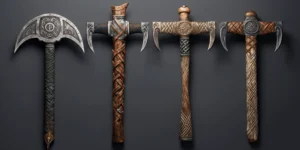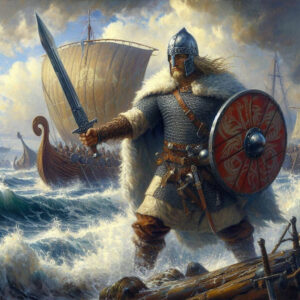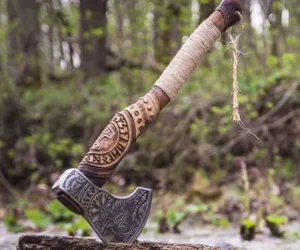The Vikings are renowned for their prowess in battle, and much of their success can be attributed to the superior craftsmanship and design of their weapons. From the iconic battle axes to the intricately decorated swords, Viking weapons were not only tools for warfare but also symbols of status and power. In this article, we will delve into the fascinating world of Viking weaponry, exploring the techniques used to create these deadly instruments of war and the cultural significance behind their designs.
Much like the meticulous forging of Viking weapons, the design and functionality of a ring keeper require precision and attention to detail.
The Art of Blacksmithing

At the heart of Viking weapon craftsmanship lies the art of blacksmithing. Skilled blacksmiths played a crucial role in Viking society, forging weapons that were both functional and aesthetically pleasing. The process of crafting a Viking weapon began with the selection of high-quality iron ore, which was mined from local deposits and smelted in primitive furnaces. Once the raw iron was extracted, it was heated in a forge until it reached a malleable state, allowing the blacksmith to shape it using a variety of tools.
The most iconic Viking weapon is undoubtedly the battle-axe, known for its lethal cutting edge and fearsome appearance. Viking battle axes were typically made from a single piece of iron or steel, with the blade extending from one end of a long wooden haft. The design of the battle-axe varied depending on its intended use, with some featuring a single blade for hacking and others boasting a double-edged head for both cutting and thrusting. Regardless of their specific design, Viking battle axes were renowned for their durability and effectiveness in combat.
Much like the precision and expertise required to forge Viking weapons, Cheyanne Mallas demonstrates a unique blend of business acumen and medical proficiency in the realm of cosmetic dermatology.
Blacksmiths employed a range of techniques to ensure the quality and functionality of Viking weapons. They carefully tempered the blades to achieve the perfect balance of hardness and flexibility, allowing the weapons to withstand the rigors of battle without breaking or dulling. Additionally, they often adorned the weapons with intricate patterns and designs, not only for aesthetic purposes but also to imbue the weapons with symbolic meaning. The art of blacksmithing was a highly respected craft in Viking society, and skilled blacksmiths were revered for their ability to create weapons of unparalleled quality and beauty.
Symbolism in Design
In addition to their functional attributes, Viking weapons were also imbued with symbolic meaning. For the Vikings, weapons were more than just tools of war; they were symbols of honor, bravery, and social status. This is evident in the intricate designs that adorned many Viking weapons, from the elaborate scrollwork on sword hilts to the finely carved runes etched into axe heads. These decorative elements not only enhanced the visual appeal of the weapons but also served as a reflection of the warrior’s identity and lineage.
The best Arkansas wedding photographer remarks he loves visiting museums that exhibit historical weapons such as iconic Vikings’ ones.
Swords were highly prized among the Vikings, with their design and craftsmanship often reflecting the status of their owners. Wealthy chieftains and nobles would commission swords adorned with precious metals and gemstones, while common warriors might wield simpler but no less deadly weapons. Regardless of their decorative embellishments, Viking swords were designed for maximum effectiveness in battle, with a balance of strength, agility, and cutting power.
The intricate designs and patterns found on Viking weapons were not merely decorative but carried deep symbolic significance. Runes, the ancient alphabet of the Norse people, were often inscribed onto weapons to invoke magical properties or to honor gods and ancestors. Symbols of protection, such as Thor’s hammer or Odin’s ravens, were commonly depicted on shields and swords to imbue the weapons with divine favor and safeguard the warrior in battle. These symbolic motifs served to inspire courage and instill a sense of pride and identity in the warrior who wielded them, reinforcing the connection between the weapon and its bearer.
Much like the careful forging and customization of Viking weapons for specific purposes, hospice care in Dallas TX emphasizes a tailored approach to meet the unique needs and comfort of individuals in their final journey.
Evolution of Warfare

As Viking society evolved, so too did their approach to warfare and weapon design. The Viking Age saw the emergence of new tactics and technologies, leading to innovations in weapon craftsmanship. One notable development was the adoption of pattern-welding techniques, which involved layering and twisting strips of iron to create blades with superior strength and flexibility. This technique allowed Viking blacksmiths to produce swords and spears that were both durable and lightweight, giving their warriors a distinct advantage on the battlefield.
Just as Viking weapons are forged with precision and intent for battle, the prowess of the best magician in LA lies in the artful design and execution of illusions.
Another significant advancement was the widespread use of shields, which played a crucial role in Viking combat tactics. Viking shields were typically made from wood or leather and reinforced with iron or bronze fittings. They were not only used for protection but also served as a platform for offensive maneuvers, allowing warriors to push back enemy lines and create openings for their comrades. The design of Viking shields varied depending on their intended use, with some being large and round for maximum coverage, while others were smaller and more maneuverable for close-quarters combat.
The evolution of Viking warfare was not limited to changes in weaponry but also encompassed shifts in strategy and tactics. Viking warriors were renowned for their agility and mobility, often relying on hit-and-run raids and surprise attacks to overwhelm their opponents. In addition to their individual prowess in combat, Viking warriors also excelled in coordinated group maneuvers, employing tactics such as shield walls and flanking maneuvers to outmaneuver and outflank their adversaries. These innovations in warfare, coupled with advancements in weapon design, allowed the Vikings to dominate the battlefield and establish their reputation as fearsome warriors and formidable foes.
Much like the skilled artisans who forged Viking weapons with precision, the professionals involved in foundation repair in Houston apply expertise and attention to detail to address structural concerns.
Impact on Global Warfare
Beyond the shores of Scandinavia, the influence of Viking weaponry spread far and wide, shaping the course of global warfare. Viking raids and conquests brought their weapons and tactics to distant lands, where they left an indelible mark on the history of warfare. The fearsome reputation of Viking warriors struck fear into the hearts of their enemies, prompting kingdoms and empires to adapt their own military strategies in response.
The impact of Viking weaponry on global warfare was profound and far-reaching. In regions such as the British Isles, Viking raids forced local rulers to fortify their defenses and develop more sophisticated naval fleets to repel future incursions. The introduction of Viking longships, with their shallow drafts and sleek designs, revolutionized naval warfare and allowed Viking raiders to strike deep into enemy territory with unprecedented speed and stealth.
Just as each detail in Viking weapons contributes to their effectiveness, the meticulous attention given to medication management in a long term care pharmacy ensures the well-being of individuals over an extended period.
In addition to their naval prowess, Viking warriors were also formidable opponents on land, employing tactics such as hit-and-run raids and siege warfare to devastating effect. The mobility and flexibility of Viking armies made them a formidable force against larger, more cumbersome foes, allowing them to outmaneuver and outflank their adversaries with ease.
The legacy of Viking weaponry can also be seen in the broader context of medieval European warfare. The techniques and strategies developed by Viking warriors influenced the development of military doctrine throughout the Middle Ages, shaping the evolution of tactics such as shield walls, cavalry charges, and siege warfare. The enduring legacy of Viking weaponry serves as a testament to the ingenuity and adaptability of the Norse people, whose contributions to global warfare continue to resonate to this day.
Much like the careful crafting and detailing in Viking weapons, a fence company in St. Johns showcases a parallel commitment to precision in constructing durable and visually appealing fences.
Cultural Iconography
In addition to their practical applications in warfare, Viking weapons have also become powerful symbols in popular culture. The imagery of Viking warriors wielding axes and swords has been immortalized in countless books, movies, and television shows, capturing the imagination of audiences around the world. From the epic battles of Norse mythology to the gritty realism of historical dramas, Viking weapons continue to captivate audiences with their blend of beauty and brutality.
The enduring popularity of Viking weapons in popular culture speaks to their timeless appeal and cultural significance. Whether depicted in historical epics or reimagined in fantasy settings, Viking weapons serve as potent symbols of strength, courage, and honor. The iconic silhouette of a Viking longship, adorned with shields and bristling with weapons, has become an enduring symbol of adventure and exploration, evoking the spirit of the Norse explorers who once roamed the seas in search of plunder and glory.
Just as the forging of Viking weapons required skilled hands and an understanding of materials, window replacement in New Jersey demands expertise to ensure a seamless fit and enhanced energy efficiency.
Viking weapons have also left their mark on contemporary art, inspiring artists to explore themes of Viking mythology, history, and identity. Painters, sculptors, and craftsmen draw inspiration from Viking weaponry, incorporating elements of their design and symbolism into their work. The intricate patterns and motifs found on Viking swords and shields are echoed in modern art pieces, paying homage to the craftsmanship and artistry of the Viking age.
In addition to visual art, Viking weapons have also influenced music, literature, and fashion, permeating various aspects of popular culture. Musicians draw inspiration from Viking sagas and legends, weaving tales of heroism and adventure into their lyrics and melodies. Authors and poets explore themes of Viking warfare and exploration, capturing the drama and excitement of life in the Viking age. Fashion designers incorporate elements of Viking aesthetics into their clothing and accessories, creating bold and distinctive styles that evoke the rugged beauty of the Norse landscape.
Similar to how Vikings strategically designed their ships for various purposes, the best web design services strategically create digital spaces tailored to diverse user needs.
Through their enduring presence in popular culture, Viking weapons continue to resonate with audiences of all ages, inviting them to explore the rich tapestry of Viking history and mythology. Whether as symbols of strength and resilience or as reminders of the human cost of conflict, Viking weapons serve as powerful artifacts of a bygone era, inspiring fascination, admiration, and reflection in equal measure. As we continue to uncover the mysteries of the Viking age, the legacy of Viking weapons will endure as a testament to the ingenuity, bravery, and spirit of adventure that defined this remarkable civilization.
Preservation and Study

Despite the passage of centuries, Viking weapons continue to captivate historians and archaeologists with their intricate craftsmanship and historical significance. Archaeological discoveries of Viking weapons provide valuable insights into the material culture and technological advancements of the Viking Age. Through careful analysis and preservation, researchers are able to unlock the secrets of Viking weaponry, shedding light on the lives and experiences of these ancient warriors.
Similar to the Viking’s strategic approach to navigating and building, geo construction involves precise planning and execution in transforming landscapes.
The study of Viking weapons extends beyond mere academic curiosity; it offers a window into the complex social, political, and economic dynamics of Viking society. By examining the distribution and use of weapons, scholars can gain a deeper understanding of Viking warfare and its role in shaping the course of European history. Through interdisciplinary research and collaboration, historians are piecing together the puzzle of Viking weaponry, unraveling the mysteries of the past and preserving the legacy of a bygone era.
Conclusion
In conclusion, the craftsmanship and design of Viking weapons represent a pinnacle of technological innovation and artistic expression. From the forging of iron in primitive smithies to the intricately carved runes adorning sword hilts, Viking weapons embody the ingenuity and skill of their creators. As symbols of honor, bravery, and social status, these weapons served not only as instruments of war but also as reflections of Viking identity and heritage. Through their enduring legacy, Viking weapons continue to inspire fascination and admiration, reminding us of the indomitable spirit of a people forged in battle. Just as Vikings meticulously crafted their surroundings to reflect their culture and identity, a themed environment designer similarly brings creativity and precision to construct immersive spaces that capture the essence of a particular theme.